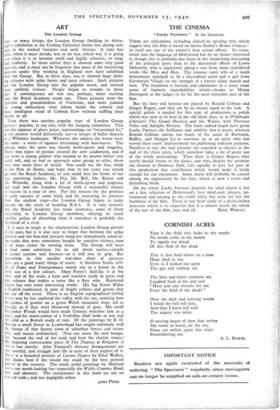ART
The London Group
Da so many things,' the London Group (holding its thirty- eighth exhibition at the Cooling Galleries) shows less daring now tan in the wicked 'twenties and early 'thirties. A time has come when it must decide, war or no war, which way it is going _whether it is to become small and hi•hly selective, or large and motherly. In those earlier days it showed some very good pictures, and it must not be forgotten that most of the interesting painters under fifty working in England now have exhibited vith the Group. But in those days, too, it showed large dash- ing pictures with spiky forms and juicy colours. Such pictures got the London Group into the popular novel, and enticed some unlikely visitors. People began to wonder in those days if contemporary art was not, perhaps, more exciting than the Royal Academy made out. These pictures were the children and grandchildren of Vorticism, and were painted by young enthusiasts over whose heads the soberer and more intelligent wind of Cubism blew without ruffling their beards at all.
Then there was another Popular type of London Group picture : popular, at any rate, with the hanging committee. This was the expanse of gluey paint, representing—or "occasioned by," as the painter would defensively say—a troupe of ballet dancers or a Wiltshire landscape. Whatever the subject the forms were the same : a series of squares alternating with bun-loaves. The colours were the same too, mostly bottle-green and magenta. These two types of picture created the new academism, and if you were a young painter who needed to be known before you could sell, and so had to approach some group or other, there were two main lines of attack. You could toe the line, think of the Prix de Rome, and hope that in ten years you would get into the Royal Academy, or you could buy the books of our four unwitting fathers, Mr. Fry, Mr. Bell, Mr. Rutter and Mr. Wilenski, along with a lot of bottle-green and magenta, and send into the London Group with a reasonable chance of success in a year or two. For this reason—by the promise of early success of some kind, and by nurturing its painters from the student stage—the London Group began to make inroads on the stock of budding R.A.'s. It is only recently that the Royal Academy has made overtures, some of them successful, to London Group members, obeying its usual sensible policy of absorbing what it considers is probably the life-blood of a rival.
It is easy to laugh at the characteristic London Group picture of the past, but it is also easy to forget that between the spiky pictures and the bun-loaf pictures hung less immediately astonish- ing works that were sometimes bought by sensitive visitors, now in all ways richer by owning them. The Group will have to find some substitute for its old shock tactics—simply to attract custom and interest—or it will lose its grip. But meanwhile in this smaller war-time show of pictures there are a good many things of merit. A Matthew Smith still- life of Pears and Pomegranates stands out as a lesson in the lively use of a few Colours. Mary Potter's Still-life is at the other end of the scale, a faint and sensitive study in greys and pale ado= that makes a noise like a flute solo. Raymond Coxon has sent some interesting works. His big North Wales is English traditional, in spite of bright yellows and greens that put one off the scent. There is an English topographical feeling in the way he has explored the valley with his eye, noticing how the gashes of granite on a green Welsh mountain slope tell as strongly as if they were blood-red instead of grey. His small November Woods would have made Cotman welcome him as a pupil, and his water-colour of a Yorkshire Dale looks as wet and yet solid as a Bewick study of rain. Of the ,paintings by R. 0. Dunlop a small Street in Leatherhead has caught extremely well the flavour of that Surrey town of suburban fences and minor brick and stucco architecture. (You can sense the new bunga- lows beyond the end of the road, and hear the electric trains.) His imposing conversation piece of The Thames at Kingston is valiant but starchy. John Tunnard's abstract Arrangements are ''erY tasteful, and struggle into life in spite of their neglect of it. There is a beautiful portrait of Lucien Pisarro by Ethel Walker, that shows how if she would she could be the best portrait Painter in the country. The small, artful paintings by Morland Lewis are worth looking for—especially the Welsh Country Road, dark and showery. The excitements in this show are not on a grand scale ; and not negligible either.
JOIN PIPER.


























 Previous page
Previous page